 W
WAnaspidomorphi (anaspidomorphs) is an extinct superclass of jawless fish.
 W
WArchipelepidiformes is an order of extinct jawless fishes in the class Thelodonti.
 W
WArchipelepis is a genus of extinct thelodont agnathans, and are the most primitive recognized thelodonts of which whole body fossils are known. Fossils of bodies and scales are currently known from Late Telychian to Wenlock-aged marine strata of northern Canada.
 W
WAteleaspididae is a prehistoric jawless fish family in the class Osteostraci.
 W
WAteleaspis is an extinct genus of primitive ostracoderm fish that lived in the Early Silurian to Early Devonian periods. Like other ostracoderms, Ateleaspis had a head shield similar to that of Cephalaspis. Species from Silurian period were found in Norway and Scotland, but now has been found also in Siberia from Early Devonian period.
 W
WAuchenaspis salteri is an extinct species of armored jawless fish of the order Thyestiida from the Late Silurian of England. In England, A. salteri's fossils are found in extreme abundance in the Lower Old Red Sandstone strata in Ledbury, Herefordshire.
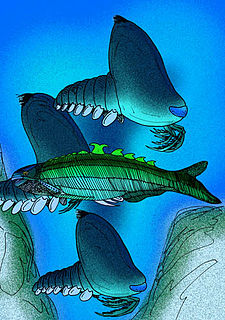 W
WBirkenia is a genus of extinct anaspid fish from Middle Silurian strata of Northern Europe, and Middle Silurian to possibly Earliest Devonian strata of Arctic Canada. Birkeniid anaspids are covered by a series of small plates on the head and rod-shaped scales in a cheveron-like pattern on the trunk.
 W
WBirkeniidae is an extinct family of jawless fish belonging to the order Birkeniiformes.
 W
WBirkeniiformes is an extinct order of jawless fish belonging to the class Anaspida.
 W
WBlieckaspis priscillae is a pteraspidid heterostracan agnathan from the Middle Devonian of North America.
 W
WCoelolepidae is an extinct family of thelodont vertebrate agnathans that lived during the Silurian.
 W
WCornovichthys is an extinct genus of jawless fish in the super class Anaspidomorphi. It is known from the Middle Devonian of Scotland.
 W
WCornuata is an extinct taxon of jawless fish that lived in the Early Silurian to Late Devonian.
 W
WCowielepis is an extinct genus of jawless fish in the class Anaspida. It is from the middle Silurian Cowie Harbour fish bed of Stonehaven, Scotland.
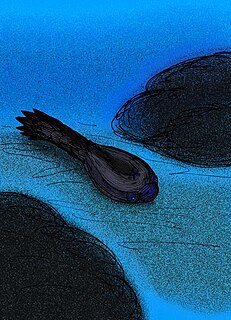 W
WCyathaspidiformes is an extinct order of heterostracan vertebrates known from extensive fossil remains primarily from Silurian to Early Devonian strata of Europe, and North America, and from Early Devonian marine strata of Siberia.
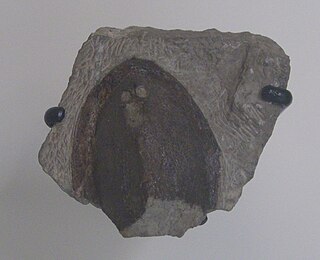 W
WDartmuthia is an extinct genus of primitive jawless fish that lived in the Silurian period in what is now Estonia.
 W
WDunyu is an extinct genus of eugaleaspidiform galeaspid known from the Silurian of Yunnan, southwestern China.
 W
WFurcacaudidae is a family of thelodontid agnathan from the Lower Devonian. It is the type family of the order Furcacaudiformes.
 W
WJamoytius kerwoodi was a species of primitive, eel-like jawless fish that lived in the Llandovery epoch of the Early Silurian period.
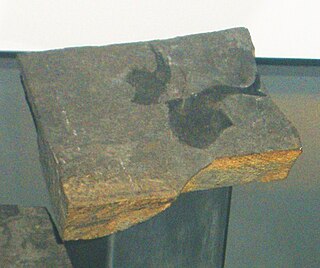 W
WLanarkia is a genus of extinct thelodont agnathan which existed in what is now Scotland and Canada during the upper Silurian period.
 W
WLasanius is a genus of basal anaspida from the Late Silurian. Its fossils are around 27 mm to 40 mm in length.
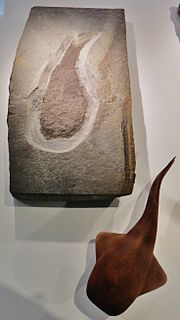 W
WLoganellia is a genus of jawless fish which lived between 430-370 million years ago, during the Silurian and Devonian periods of the Paleozoic. Loganellia belonged to the Thelodonti class and like other Thelodonts possessed scales instead of plate armor.
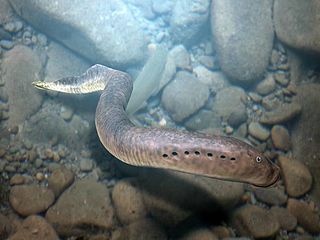 W
WMesomyzon mengae is an extinct lamprey from freshwater strata of the Early Cretaceous-aged Yixian Formation, in China. So far, M. mengae is the only lamprey, and by default, the only agnathan known from post-Paleozoic fossils.
 W
WMyllokunmingiidae is a group of very early, jawless prehistoric fish (Agnathans) which lived during the Cambrian period. The Myllokunmingiids are the earliest known group of craniates. The group contains three genera, Haikouichthys, Myllokunmingia, and Zhongjianichthys. Their fossils have been found only in the Maotianshan Shales lagerstätte.
 W
WNochelaspis is an extinct genus of Galeaspid. It lived during the Lochkovian period in Lower Devonian China.
 W
WPharyngolepis is an extinct genus of primitive jawless fish that lived in the Silurian period of what is now Norway.
 W
WPhlebolepididae is an extinct thelodont agnathan family in the order Thelodontiformes.
 W
WPhlebolepis is an extinct thelodont agnathan genus belonging to the family Phlebolepididae. Whole fossils are found in Early Silurian (Llandovery) aged strata from Saaremaa, Estonia. Phlebolepis elegans was average-sized for a thelodont, 7 cm long.
 W
WPipiscius zangerli is an extinct species of lamprey that lived about 300 million years ago, during the Middle Pennsylvanian Epoch of the Carboniferous Period.
 W
WPterygolepis is an extinct genus of jawless fish belonging to the order Birkeniiformes.
 W
WRhyncholepis is an extinct genus of anaspida from the Late Silurian. It was 26 cm long.
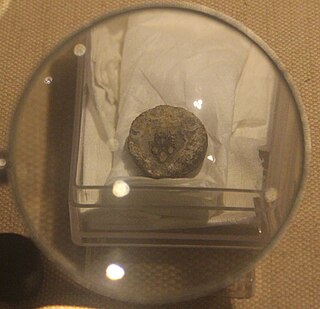 W
WShuyu is an extinct genus of early jawless vertebrate from the Early or Middle Silurian period. It is the basalmost known eugaleaspidiform galeaspid and it lived in what is now northwestern Zhejiang Province, Southeast China. It is known from more than 20 headshields and at least 20 of them include three-dimensionally preserved neurocrania. The specimens of Shuyu were collected from the lower part of Maoshan Formation, located in Changxing District. Shuyu zhejianensis was first assigned by Pan, 1986 to a species of Sinogaleaspis. The genus was first named by Zhikun Gai, Philip C. J. Donoghue, Min Zhu, Philippe Janvier and Marco Stampanoni in 2011 and the type species is Shuyu zhejianensis.
 W
WThelodontiformes is an extinct order of jawless fish of the Silurian.
 W
WThelodus is an extinct genus of thelodont agnathan that lived during the Silurian period. Fossils have been found in Europe, Asia and North America. Unlike many thelodonts, species of Thelodus are known not only from scales, but from impressions in rocks. Some species, such as the Canadian T. inauditus, are thought to be comparable in size to other thelodonts, i.e., from 5 to 15 centimeters in length. The scales of the type species, T. parvidens of Silurian Great Britain, however, reach the size of coins, and, if proportioned like other thelodonts, such as Loganellia, the living animal would have been about one meter in length.
 W
WThyestes is an extinct genus of osteostracan agnathan vertebrate of Europe whose fossils are found in Middle to Late Ludlow-aged marine strata of Late Silurian Europe. Individuals of Thyestes superficially resembled Cephalaspis, but were more closely related to Auchenaspis and Tremataspis.
 W
WThyestiida is an order of bony-armored jawless fish in the extinct vertebrate class Osteostraci.
 W
WTremataspis is a genus of an extinct osteostracan agnathan from the Silurian period of what is now Estonia.
 W
WZenaspida is an extinct order of jawless fish.
 W
WZenaspididae is an extinct family of jawless fish in the order Zenaspida.
 W
WZhongjianichthys rostratus is an extinct basal chordate that lived in the Cambrian period, approximately 530 million years ago. It is sometimes regarded as an early fish, and therefore as one of the first vertebrates. Zhongjianichthys is named after Zhongjian in China.